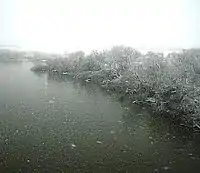Mintuci
Mintuci (Ainu ミントゥチ; also mintuci kamuy, in Japanese literature also spelled as mintsuchi (ミンツチ)[1]) is a supernatural creature from Ainu mythology, half-man-half-beast,[2][3] and a spirit of water element.[1] The word „mintuci” is probably related to Japanese word mizuchi, a type of a dragon connected to water.[4] Mintuci are often described looking like kappa.[1][4]

According to legends, when the Japanese came to Hokkaido to establish trade relations with the Ainu during the Edo period, a smallpox demonsneaked on their ship.[5] A smallpox outbreak killed many Ainu.[4] Okikurumi (according to other versions, the Ainu themselves) [5] made 61 puppets from wormwood stalks and sent them to fight the demon.[6] All but one of the puppets drowned, and the remaining one managed to defeat the smallpox demon.[1] The puppets became mintuci kamuy, helping people in case of illness or adversity.[4][6]
Mintuci have been described as having bald patches on their heads, purple-red skin, and bird or frog legs.[2][1] The arms of the mintuci, like those of the kappa, were connected inside, so after ripping one out, the other fell out on its own.[3] Mintuci from different regions have their own distinctive features: the mintuci from the Ishikari River are completely bald, both female and male. Mintuci from Ikeda in the Tokachi region look like little old men or old ladies.[4]
According to popular belief, mintuci control fish and can bring luck to fishermen in exchange for a drowned offering.[2][4] Mintuci were also credited with the ability to increase the number of prey while hunting.[4] There are legends that adopting mintuci disguised as a girl would bring prosperity to the adopting family.[2] The prosperity of Asahikawa and Saru river was attributed to mintuci protection.[4]
Like kappa, mintuci can hunt people and livestock by dragging them under water, spy on people,[4] and possess women who would then seduce men.[3]
References
- Александр Борисович Спеваковский (1988). Духи, оборотни, демоны и божества айнов: религиозные воззрения в традиционном айнском обществе (in Russian). Изд-во "Наука", глав. ред. восточной лит-ры. Retrieved 2020-11-12.
- Tobe, Tamio., Shibuya, Yūji., 戶部民夫., シブヤ, ユウジ. (1994). Nihon yōkai hakubutsukan. Tōkyō: Shin Kigensha. ISBN 4-88317-240-6. OCLC 34324882.CS1 maint: multiple names: authors list (link)
- Kusano, Takumi, 1956-, Shibuya, Yūji, 1959-, 草野, 巧, 1956-, シブヤ, ユウジ, 1959- (1997). Gensō dōbutsu jiten. 新紀元社. ISBN 4-88317-283-X. OCLC 675909434.CS1 maint: multiple names: authors list (link)
- Murakami, Kenji, 1968-, 村上健司, 1968- (2005). Nihon yōkai daijiten. Tōkyō: Kadokawa Shoten. ISBN 4-04-883926-8. OCLC 64576243.CS1 maint: multiple names: authors list (link)
- Gensō sekai no jūnintachi : Truth in fantasy9. 4. 新紀元社. 1991. ISBN 4-915146-44-8. OCLC 673449350.
- I. A. Morozov (2011). Fenomen kukly v tradit︠s︡ionnoĭ i sovremennoĭ kulʹture : krosskulʹturnoe issledovanie ideologii antropomorfizma (PDF). Indrik. Moskwa. ISBN 978-5-91674-114-8. OCLC 711737736. Retrieved 2020-11-12.